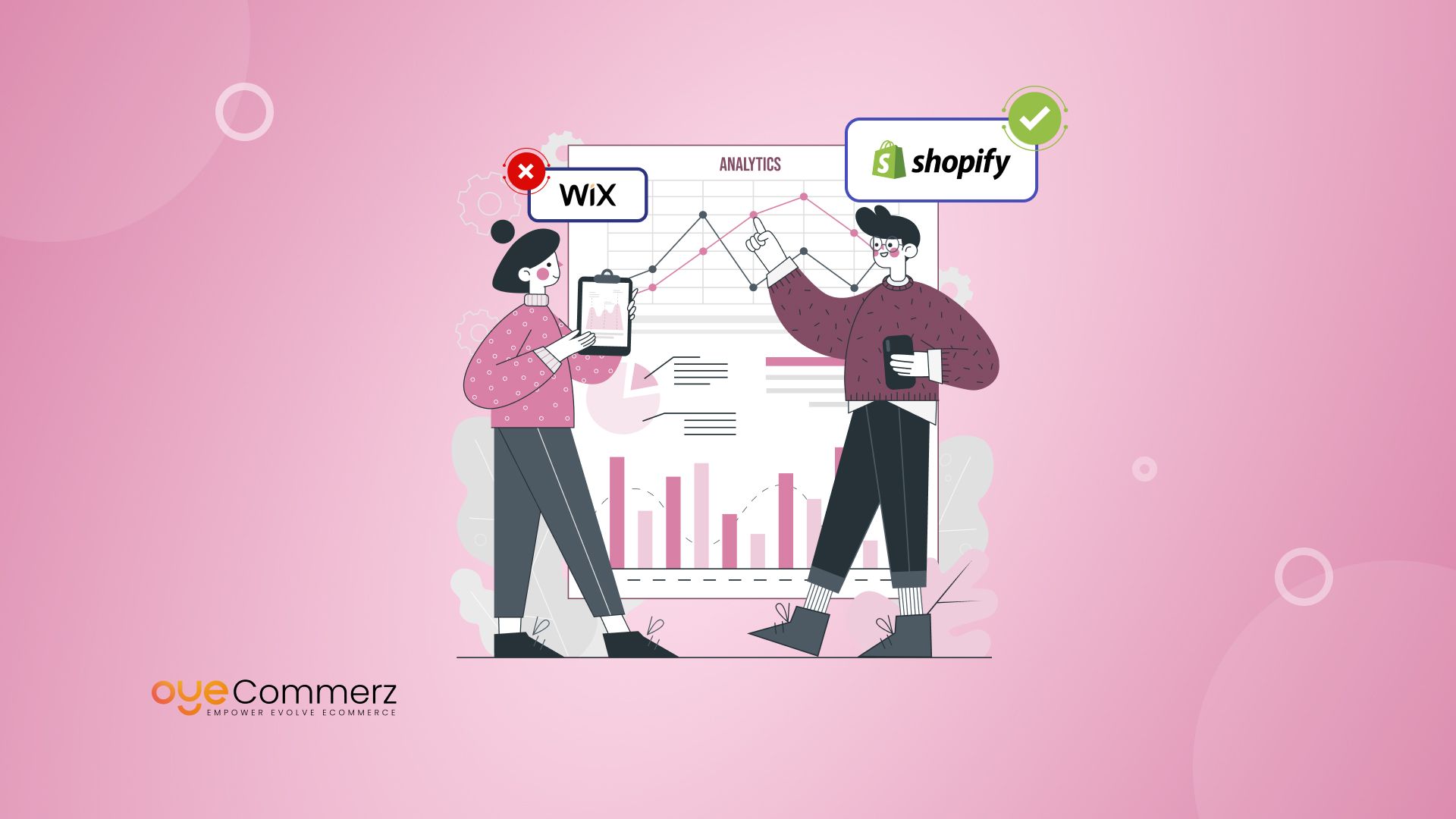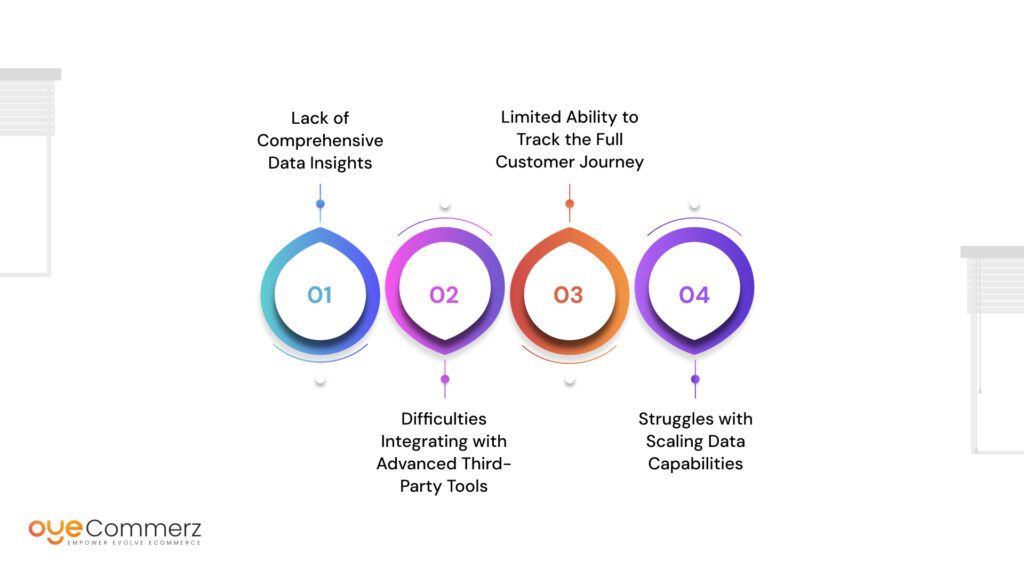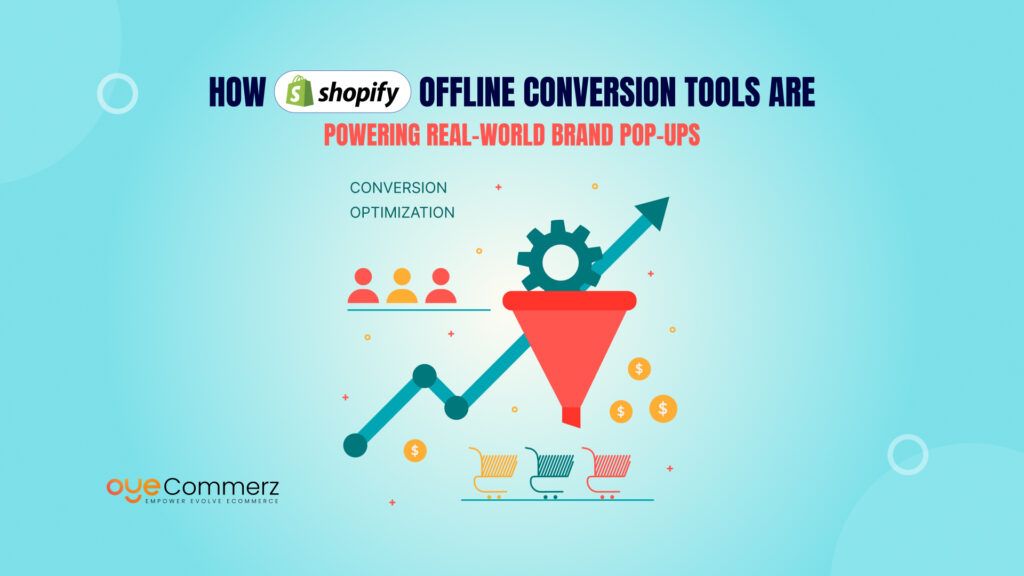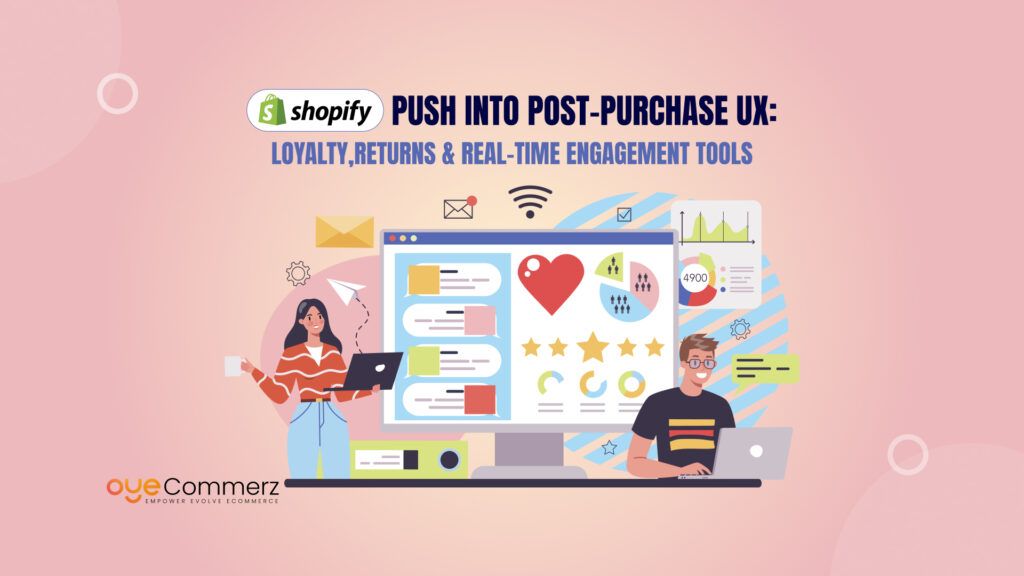Have you ever felt stuck trying to understand what’s working and what’s not in your Wix store? This might sound all too familiar if you’re an existing Wix business owner. The problem isn’t you—it’s the limited analytics tools that Wix offers. Businesses that switch to Shopify often report a 25% increase in actionable insights, thanks to Shopify’s advanced analytics.
This isn’t just about numbers; it’s about empowering you to make smarter decisions. Whether it’s tracking sales trends, customer behavior, or inventory performance, Shopify’s analytics tools are designed to give you a clearer, deeper understanding of your business, something Wix often struggles to deliver. Let’s dive into how Shopify makes analytics simple yet powerful and why it’s a game-changer for business owners like you.
Table of Contents
ToggleThe Role of Analytics in E-commerce
Why Analytics Matter: Turning Data into Actionable Insights
In the fast-paced world of e-commerce, data is not just numbers—it’s the backbone of every successful decision. Analytics empower businesses to understand their customers, improve strategies, and stay ahead of the competition. Decisions are often based on guesswork without robust analytics, leading to missed opportunities and inefficiencies.
For e-commerce businesses, analytics reveal key patterns such as which products are trending, what marketing campaigns are driving sales, and how customers interact with the store. This information can be used to optimize strategies and maximize revenue, making analytics a critical tool for growth. The e-commerce industry is expected to reach 6.54 trillion US dollars in sales, highlighting the critical need for robust analytics to navigate this expansive market.
Key Areas Where Analytics Make a Difference
- Marketing Performance:
Analytics allow you to track the performance of campaigns, measure return on investment (ROI), and identify channels that bring the most traffic and conversions.- Example Metrics: Click-through rates, conversion rates, and customer acquisition cost (CAC).
- Sales Optimization:
Understanding sales trends helps identify high-performing products and areas of improvement. It also allows for dynamic pricing and better inventory management.- Example Metrics: Average order value (AOV), revenue per user (ARPU).
- Customer Retention Strategies:
Analytics can uncover patterns in customer behavior, helping to craft personalized experiences and loyalty programs.- Example Metrics: Repeat purchase rates, customer lifetime value (CLV).
Types of Data Analytics in E-commerce
There are four main types of analytics used in e-commerce, each serving a distinct purpose:
These analytics types work in tandem, transforming raw data into actionable insights. For instance, while descriptive analytics may show a decline in sales, diagnostic analytics can reveal the reason, and predictive analytics can suggest potential outcomes based on various scenarios.
Why Shopify Analytics Are Superior to Wix in These Areas
When comparing Shopify analytics with Wix, the difference lies in-depth and functionality. Shopify’s analytics cover all four types of data analytics, whereas Wix leans heavily on descriptive analytics, leaving gaps in diagnostic, predictive, and prescriptive areas. This limitation often frustrates Wix users, as they lack the comprehensive insights needed for strategic decision-making.
Stay tuned as we explore Wix’s analytics offerings in the next section and uncover the challenges Wix users face when relying on its basic tools.
Exploring Wix Analytics
Overview of Wix’s Analytics Offerings
Wix analytics offer a basic entry point for e-commerce owners looking to understand their store’s performance. The platform is known for its user-friendly interface, making it an appealing choice for beginners. However, the simplicity of its tools often limits its ability to provide comprehensive insights into business operations.
Wix focuses primarily on descriptive analytics, such as tracking visitor statistics and generating simple sales reports. While these features are easy to access and understand, they lack depth and advanced functionality, leaving many business owners unable to make data-driven decisions effectively. Wix provides basic e-commerce statistics covering metrics like order numbers, conversion rates, total revenue, and total sessions, offering essential insights for small-scale operations.
Key Features of Wix Analytics
- Visitor Statistics:
Wix provides essential data about website visitors, including traffic volume, geographical locations, and the pages they interact with the most. This can be helpful for businesses trying to understand where their audience comes from and what content drives engagement.- Limitations: The metrics provided are high-level and don’t allow for deeper segmentation or behavior analysis.
- Sales Reports:
Businesses can access reports that outline their revenue, sales performance by product, and overall financial performance.- Limitations: The reports focus solely on sales outcomes, offering no insight into underlying factors like customer behavior or marketing impact.
- Marketing Campaigns:
Wix offers basic tracking for marketing efforts, including email campaigns and social media ads. Users can monitor clicks, opens, and conversions within the Wix ecosystem.- Limitations: Campaign tracking is limited to platforms directly integrated with Wix, which hinders a broader analysis.
These gaps leave businesses struggling to meet customer expectations or expand into new markets. In contrast, Shopify’s e-commerce-first approach ensures robust tools to support even the most demanding operations.
2. Scalability Issues
As businesses grow, their operational complexities increase. Wix’s infrastructure is not designed to handle high transaction volumes or large catalogs, leading to performance bottlenecks.
Key Scalability Challenges with Wix:
- Traffic Handling: During peak periods like sales or holiday promotions, Wix stores often experience slower load times, frustrating customers and reducing conversions.
- Product Catalog Limitations: Managing a catalog of thousands of products on Wix can become cumbersome, with slower backend performance and limited organizational tools.
- Transaction Volume: Wix struggles to process high transaction volumes efficiently, making it less suitable for growing businesses.
Shopify, on the other hand, is designed to scale effortlessly. Its infrastructure supports businesses of all sizes, ensuring smooth operations regardless of traffic spikes or catalog size.
3. Lack of Customization
For businesses looking to create unique customer experiences or tailor their workflows, Wix’s limitations in customization can be a significant drawback.
Shopify’s flexibility empowers businesses to innovate, while Wix’s rigid framework often forces businesses to compromise on their vision.
4. Performance Concerns
Page load speed is a critical factor in user experience and search engine optimization (SEO). Wix’s platform often falls short of delivering optimal performance for e-commerce businesses.
- Slower Load Times: Wix’s reliance on a one-size-fits-all approach for hosting can lead to slower page loads, especially for larger stores.
- Impact on Conversions: Studies show that even a one-second delay in load time can reduce conversions by up to 7%.
- Limited Global CDN: Wix’s content delivery infrastructure is less robust compared to Shopify’s global CDN, which ensures fast load times regardless of user location.
For businesses aiming to build a future-proof business, Shopify’s performance optimizations ensure smooth and reliable operations, even during high-traffic events.
5. SEO and Marketing Gaps
Effective marketing and SEO are critical for driving traffic and conversions. Wix offers basic tools in these areas but lacks the advanced features needed to compete in the dynamic e-commerce space.
With fewer native options for marketing and SEO, Wix users often rely on third-party tools, increasing costs and complicating workflows. Shopify, with its built-in features and seamless integrations, provides a complete solution for driving traffic and boosting sales.
Common Challenges Faced by Wix Users
1. Lack of Comprehensive Data Insights
For many Wix users, the inability to access detailed and actionable insights becomes a significant roadblock. Wix analytics focus heavily on descriptive data, such as total visits or sales numbers, but they fail to provide deeper insights into customer behavior, campaign effectiveness, or long-term trends.
- Impact: Users might see declining sales but have no way to determine the causes, such as ineffective marketing, product issues, or customer churn.
2. Difficulties Integrating with Advanced Third-Party Tools
Wix’s ecosystem is not as robust as platforms like Shopify. Many advanced tools, such as Google Analytics 4, Facebook Pixel, or third-party CRMs, require manual setup or don’t integrate seamlessly. This limitation restricts businesses from accessing data across multiple sources.
- Impact: Without comprehensive data integration, users miss out on cross-platform insights that could improve their marketing strategies and sales.
3. Limited Ability to Track the Full Customer Journey
Tracking a customer’s journey from the first visit to a completed purchase (or post-purchase activity) is critical for optimizing sales funnels. Wix provides fragmented data that does not connect the dots between customer touchpoints.
- Impact: This leads to missed opportunities for identifying pain points or drop-off stages in the sales process.
4. Struggles with Scaling Data Capabilities
As businesses grow, their data needs increase exponentially. Wix’s analytics tools, designed for smaller datasets, struggle to manage large inventories, high sales volumes, or multi-channel sales data.
- Impact: Businesses may find themselves unable to keep up with growth or unable to compete with data-driven competitors.
The limitations of Wix analytics often compel businesses to look for more robust platforms like Shopify, which offer advanced data insights and seamless integrations to overcome these challenges.
Shopify Analytics: A Deep Dive
Overview of Shopify’s Analytics Suite
Shopify analytics stands out as a professional-grade solution designed for businesses that prioritize data-driven decision-making. Unlike Wix, Shopify’s analytics tools are built to scale with your business, offering a wide range of metrics, customizations, and advanced insights.
Shopify provides more than just numbers; it offers actionable insights to help you make strategic decisions. Whether you’re managing a small online store or scaling to enterprise levels, Shopify analytics adapt to your needs, giving you a clear edge in optimizing marketing, sales, and operations.
Core Features of Shopify Analytics
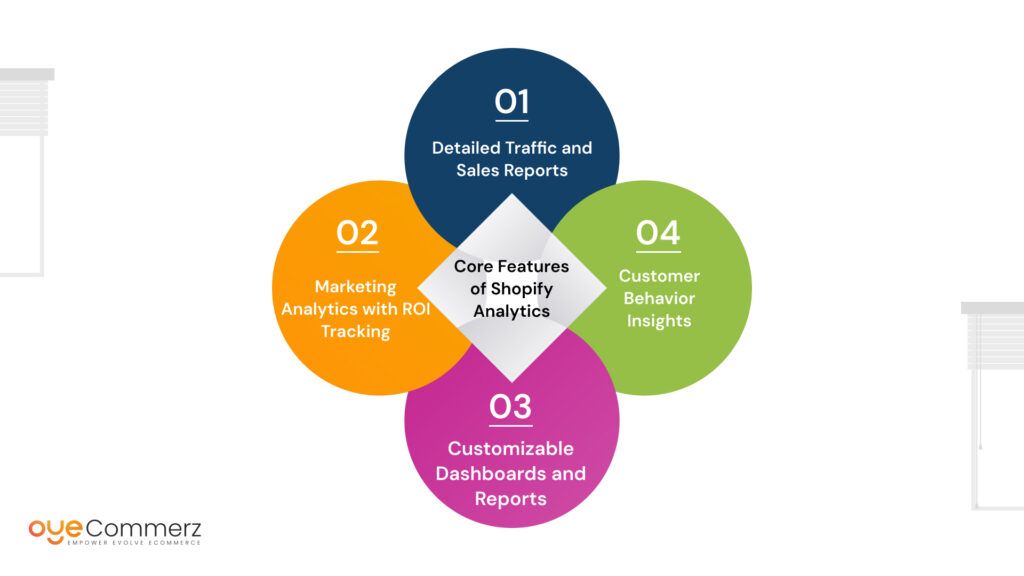
- Detailed Traffic and Sales Reports:
Shopify goes beyond tracking page views and sales by offering granular data about customer behavior, traffic sources, and revenue trends.- Example Metrics: Product-level performance, referral traffic, and cart abandonment rates.
- Marketing Analytics with ROI Tracking:
Shopify allows you to measure the success of marketing campaigns across channels like email, social media, and ads.- Example Metrics: Campaign ROI, conversion rates, and cost-per-click analysis.
- Customizable Dashboards and Reports:
Shopify’s reporting tools enable you to create custom dashboards that align with your specific business goals. - Customer Behavior Insights:
Track how customers interact with your store, from browsing to checkout, providing valuable insights for personalization and retention.
Advanced Capabilities
- Integration with Third-Party Tools:
Shopify’s ecosystem includes seamless integrations with tools like Google Analytics, Facebook Pixel, and CRM systems, ensuring data from multiple platforms can be unified.- Example: Use Facebook Pixel to track ad performance and link it directly to Shopify’s reports.
- Real-Time Analytics:
Shopify’s real-time data updates help businesses make immediate adjustments, whether it’s launching a promotion or responding to inventory shortages. - Multi-Channel Reporting:
Shopify consolidates data from online stores, marketplaces, and social media channels into a single dashboard, simplifying omnichannel management.
Why Shopify Analytics Are Superior to Wix
- Predictive Analytics: Shopify predicts future trends based on past data, providing proactive recommendations.
- Advanced Financial Reports: Shopify breaks down profit margins, costs, and revenues in detail, helping businesses stay financially sound.
- Scalable Tools: Whether you’re handling 100 or 10,000 sales, Shopify’s analytics can manage the load seamlessly.
Technical Comparison: Shopify vs. Wix Analytics
When evaluating e-commerce platforms, the quality of analytics can make or break your business growth. Let’s break down the technical differences between Shopify and Wix analytics to understand why Shopify analytics are superior to Wix.
1. Data Collection and Accuracy
Shopify’s analytics infrastructure is built to capture data with high precision across multiple touchpoints, from website traffic to sales, inventory, and customer behavior.
- Shopify Advantage: Seamless integration with third-party tools like Google Analytics and CRM systems ensures accuracy and depth. Shopify also supports advanced features like UTM tracking for detailed campaign performance analysis.
- Wix Limitation: Wix’s data tracking is basic, often focusing on surface-level metrics like page views and simple sales data. The platform struggles with tracking complex events such as multi-channel conversions or cross-device interactions.
2. Customization Options
Custom reports and dashboards are essential for businesses with unique needs. Shopify’s analytics offer a high degree of customization, allowing users to create tailored reports that align with specific goals.
- Shopify Advantage: Users can filter, sort, and visualize data to match their exact requirements. For example, you can create reports for product-specific sales trends, regional performance, or ad spend efficiency.
- Wix Limitation: Wix offers limited customization, with predefined templates that cannot adapt to advanced reporting needs.
3. Integration with Ecosystems
Analytics often require data from multiple sources, such as social media, advertising platforms, and email campaigns. Shopify’s vast app marketplace and API capabilities make this integration seamless.
- Shopify Advantage: Shopify integrates with thousands of apps, including Google Ads, Facebook Pixel, and Mailchimp, offering a unified data view.
- Wix Limitation: Wix’s ecosystem is smaller, and many third-party tools require manual workarounds for integration, leading to fragmented data.
4. Real-Time Capabilities
Access to real-time data enables businesses to respond quickly to trends and make agile decisions. Shopify excels in delivering live updates across all metrics, whereas Wix often experiences delays.
- Shopify Advantage: Instant data refreshes for inventory, sales, and traffic allow for immediate actions, such as launching a flash sale or restocking a popular product.
- Wix Limitation: Data updates on Wix can lag, making it challenging to respond quickly to time-sensitive events.
5. Scalability for Growing Businesses
For businesses planning to scale, analytics must handle large data volumes without compromising performance. Shopify analytics are designed to support growth, from small businesses to enterprise-level operations.
- Shopify Advantage: Scalable infrastructure, detailed segmentation, and enterprise-ready features make Shopify ideal for growing e-commerce businesses.
- Wix Limitation: Wix analytics struggle to keep up with the demands of businesses experiencing rapid growth or managing large inventories.
Why Shopify Excels: Data-Driven Success Stories
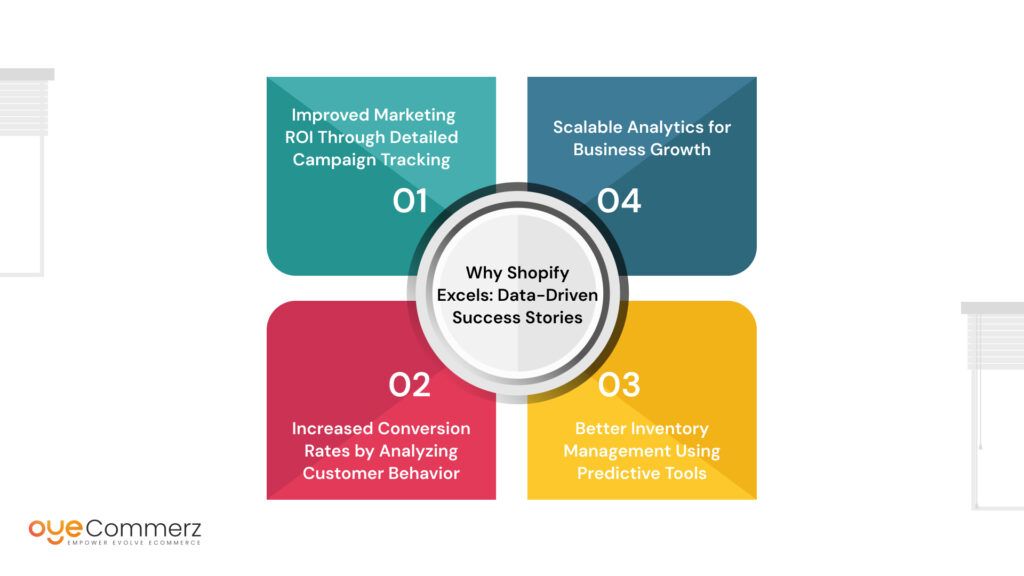
Shopify analytics empowers businesses to make smarter decisions, leading to tangible results. Here’s how Shopify users have leveraged its advanced analytics tools to achieve success:
1. Improved Marketing ROI Through Detailed Campaign Tracking
With Shopify’s marketing analytics, businesses can evaluate which campaigns yield the highest return on investment (ROI).
- Impact: Users allocate budgets more effectively, focusing on strategies that drive conversions and minimize wasted spending.
2. Increased Conversion Rates by Analyzing Customer Behavior
Shopify’s customer behavior insights provide a clear picture of how visitors interact with your store.
- Impact: Businesses can optimize their store layout, improve product recommendations, and simplify checkout processes, leading to higher conversion rates.
3. Better Inventory Management Using Predictive Tools
Shopify’s inventory analytics help businesses anticipate demand and prevent overstocking or stockouts.
- Impact: Improved cash flow and customer satisfaction through timely product availability.
4. Scalable Analytics for Business Growth
As businesses expand, Shopify scales effortlessly, offering enterprise-level tools without requiring a platform switch.
- Impact: Users can manage data from multiple locations, channels, and audiences under one roof.
By leveraging Shopify’s robust analytics suite, businesses can unlock their full potential, achieving measurable growth and efficiency.
By addressing these unique needs of US-based businesses, Shopify solidifies its position as a platform that not only meets current demands but also anticipates future trends. Next, we’ll guide you on how to transition seamlessly from Wix to Shopify, ensuring you take full advantage of Shopify’s powerful marketing features.
Actionable Steps for E-commerce Business Owners
Whether you’re currently using Wix or considering Shopify, taking the right steps to enhance your analytics can dramatically improve your e-commerce business. Below are tailored recommendations for both Wix users and those ready to transition to Shopify.
If You’re Using Wix:
- Supplement with External Tools
Wix’s analytics may be basic, but external tools can help fill in the gaps.- Google Analytics: Integrate Google Analytics for more detailed traffic and conversion tracking.
- Facebook Pixel: Use this tool to better understand your ad performance and retarget customers effectively.
- CRM Software: Connect a customer relationship management tool to analyze and track customer behavior beyond Wix’s capabilities.
- Tip: These integrations may require manual setup but can provide deeper insights into your marketing and sales performance.
- Monitor Key Metrics Manually
Since Wix doesn’t offer predictive or diagnostic analytics, you’ll need to manually track and analyze key performance indicators (KPIs).- Focus on:
- Conversion rates
- Customer acquisition costs (CAC)
- Customer lifetime value (CLV)
- Focus on:
- Tip: Regularly exporting data to spreadsheets or visualization tools like Excel or Tableau can help you track trends over time.
- Work Around Limitations
Wix’s limitations in scalability and customization can be challenging, but there are ways to adapt:- Use third-party apps for advanced analytics or email marketing.
- Leverage A/B testing tools to optimize your website and campaigns.
- Consider hiring a data analyst to interpret your Wix data and create actionable strategies.
If You’re Ready to Transition to Shopify:
- Migrate Data Strategically
Transitioning from Wix to Shopify requires careful planning to retain your historical data.- Use migration tools or services offered by Shopify to ensure a smooth transfer.
- Retain customer data, sales history, and inventory details during migration.
- Tip: Engage Shopify’s support team to minimize disruptions during the migration process.
- Leverage Shopify’s Analytics Tools
Shopify’s built-in analytics suite provides detailed insights into every aspect of your business. Start by exploring these key features:- Traffic reports: Understand where your visitors are coming from.
- Sales performance: Identify top-selling products and revenue trends.
- Customer behavior: Analyze how customers interact with your store.
- Tip: Use Shopify’s customizable dashboards to prioritize the metrics most relevant to your business goals.
- Integrate Advanced Tools for Maximum Insights
Shopify integrates seamlessly with advanced analytics platforms and marketing tools, enabling you to take your strategy to the next level.- Google Analytics 4: For comprehensive tracking across devices and channels.
- Facebook Pixel: For advanced ad tracking and retargeting campaigns.
- Email Marketing Tools: Platforms like Klaviyo or Mailchimp offer robust insights into email campaign performance.
- Automate and Scale with Shopify’s Ecosystem
Shopify’s analytics tools aren’t just about insights—they’re about action. Use automation to streamline operations and focus on scaling.- Set up automated inventory alerts using Shopify’s predictive analytics.
- Schedule regular reports to track progress on key goals.
By addressing these unique needs of US-based businesses, Shopify solidifies its position as a platform that not only meets current demands but also anticipates future trends. Next, we’ll guide you on how to transition seamlessly from Wix to Shopify, ensuring you take full advantage of Shopify’s powerful marketing features.
Take the Leap with OyeCommerz
Your e-commerce journey deserves a platform that grows with you. At OyeCommerz, we specialize in empowering businesses like yours with Shopify’s advanced analytics and tools.
Here’s what you’ll gain:
- Deeper Insights: Understand your customers, track trends, and forecast with precision.
- Smarter Decisions: Leverage data to optimize your marketing, sales, and inventory strategies.
- Seamless Growth: Scale effortlessly with a platform built to support your ambitions.
Let OyeCommerz help you harness the full potential of Shopify analytics and leave limitations behind.
Contact Us Today and take the first step toward data-driven success!
Contact to Migrate your Site to Shopify Now
Final Thoughts
Wix may work for basic needs, but as your business grows, its limitations in scalability, customization, and performance can hold you back. Shopify, purpose-built for e-commerce, offers the advanced tools, flexibility, and innovation needed to thrive in today’s dynamic market.
If you’re ready to future-proof your business and unlock new growth opportunities, Shopify is the platform to make it happen. Get Started—your future starts now.

